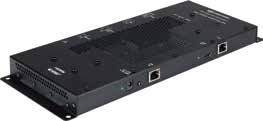As if there were only three headaches that comes along with the proliferation of BYOx. Now even more “Things” are demanding to connect to enterprise endpoints and display to stream video.
LET’S TALK BYOD LAPTOPS
On second thought—let’s not. Whether an institution-supplied or personal laptop, people have become accustomed to carrying their laptops, hopping on Wi-Fi, and setting up shop anywhere. And you’ve enabled them to do so. Unless your facility is still using dialup modems, consider making it a company policy that if a mobile device has port to connect to the Internet or Intranet via a wired connection, then plug it in. Make it part of the mobile device management (MDM) policy that you’ve been working on. Streaming video over Wi-Fi is critical in many instances, but it is the biggest Wi-Fi bandwidth hog.
PHANTOM WI-FI BANDITS
As demand for critical streaming video over Wi-Fi rises, the need to manage bandwidth use is becoming increasingly important. Unwittingly, employees are using Wi-Fi bandwidth not only because they are not connecting their laptops to Ethernet, but also by keeping their personal tablets and smartphones continuously connected to the company Wi-Fi. Surely using the company wired or Wi-Fi network for personal use such as streaming music or watching social media videos is a sensitive topic. However it might not seem so sensitive when half the employees weren’t able to watch an important earnings statement delivered by the company president who was using a Wi-Fi camera. If making it a company policy seems a bit strong, maybe start by creating a Wi-Fi bandit campaign. They’ll thank you when their work email loads more quickly on their tablet.
GETTING IN THE ZONE
In North America, 24 channels in the 5GHz U-NII band have been set aside for low power “white space” operations, ideal for wireless HDMI connections. Additional channels have been designated in the 60GHz “millimeter wave” band for similar operations. The difference between the operation on the two bands of frequencies is that 5GHz signals may penetrate walls and glass, while 60GHz signals will not.
The Wireless High Definition Interface (WHDI) system is a good choice for professional AV applications that require 1080p/60 streaming. Basic WHDI systems use 9 of the 24 “white space” 5GHz channels to make wireless HDMI connections, while more advanced models that implement transmit power control (TPC) and dynamic frequency selection (DFS) can use all 24 channels. Signal latency through a WHDI system is very low; less than 1 millisecond.
For 60GHz operation, SiBEAM (Wireless High Definition) technology is employed. The channels in this band are about 2GHz in width, also allowing full-bandwidth streaming of 1080p/60 content and providing expansion for wireless streaming of Ultra HD video. Because radio waves are so small at this frequency (.06 inches), transmitter and receiver chips can contain multiple, steerable antenna arrays to ensure reception from line-of-sight (LOS) and reflected signals. Like WHDI, latency is very low and less than 1 millisecond.
Both systems can be used to make wireless connections from presentation switchers to projectors and monitors, or from remote video cameras such as drones. They’ve also been employed to link multi-screen command-and-control systems to secondary monitors and installed on mobile hospital carts for observation and instruction during medical procedures.
Information courtesy of Crestron, Kramer, and InfoComm International.
Crestron 4K DigitalMedia 8G+ Receiver & Room Controller w/ScalerCrestron 4K DigitalMedia 8G+ Receiver & Room Controller w/Scaler
The What: The Crestron 4K DigitalMedia 8G+ Receiver & Room Controller w/Scaler provides an advanced one-box interface solution for a single display device as part of a complete DigitalMedia System. It includes built-in 4K/60 scaler and analog audio output, and connects to the DM 8G+ output of a DM Switcher or Transmitter via CAT5e, DM 8G, or DM Ultra Cable.
The What Else: It functions as a DM 8G+ receiver, 4K/60 video scaler, and control interface, providing a single HDMI output along with an analog audio output, plus Ethernet, RS-232, IR, and relay control ports. In addition to DM 8G+, it is also compatible with HDBaseT, allowing it to be connected directly to an HDBaseT certified source. Its compact, low-profile design allows the unit to be installed discreetly behind a flat panel display or above a ceiling mounted projector.
More Info:www.crestron.com

